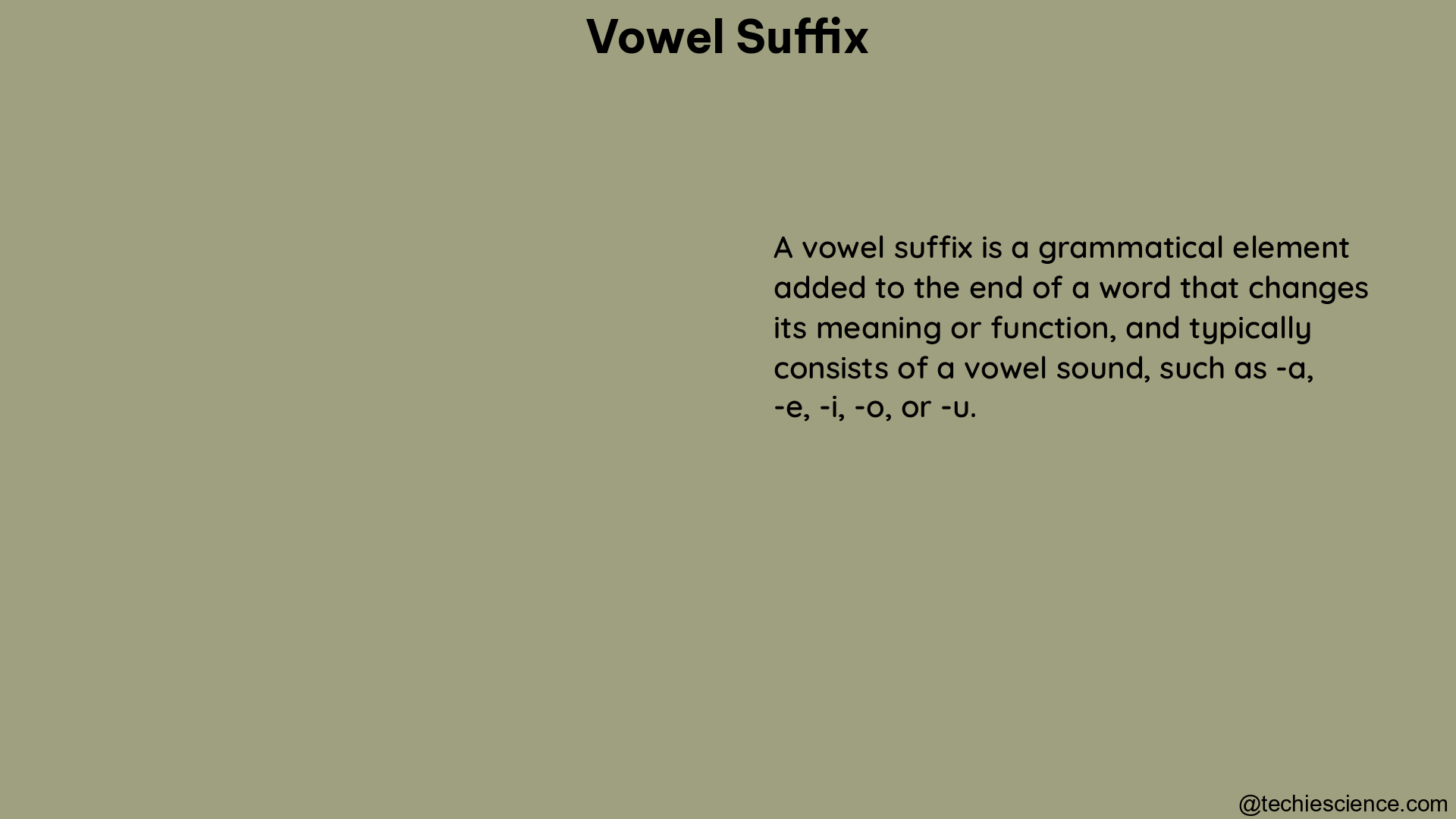Vowel suffixes are an essential component of the English language, playing a crucial role in forming verbs, adjectives, and adverbs. As a language learner or enthusiast, understanding the rules and nuances of adding vowel suffixes can significantly enhance your proficiency in written and spoken English. This comprehensive guide will delve into the intricacies of vowel suffixes, providing you with a deep understanding of the subject matter and equipping you with the necessary skills to navigate the complexities of this linguistic phenomenon.
Understanding Vowel Suffixes
Vowel suffixes are affixes that begin with a vowel sound, such as ‘a,’ ‘e,’ ‘i,’ ‘o,’ or ‘u.’ These suffixes are added to the end of base words to modify their meaning or grammatical function. In the English language, some of the most common vowel suffixes include ‘-ing,’ ‘-ed,’ ‘-er,’ ‘-est,’ and ‘-y.’
Rules for Adding Vowel Suffixes

Mastering the rules for adding vowel suffixes is crucial for ensuring accurate and consistent usage in your writing and speech. Let’s explore the four primary rules that govern the addition of vowel suffixes:
1. Double Consonant Rule
When adding a vowel suffix to a base word that has a single consonant after a single vowel, the consonant is doubled. This rule helps to maintain the short vowel sound in the base word.
Example: skip + ing = skipping
2. Drop the ‘e’ Rule
When adding a vowel suffix to a base word that ends with a silent ‘e,’ the ‘e’ is dropped before the suffix is added. This rule ensures a smooth transition between the base word and the suffix.
Example: time + er = timer
3. No Change Rule
If a base word ends with two consonants or a vowel team (a combination of two vowels that make a single sound), the vowel suffix is simply added without any changes to the base word.
Example: help + ing = helping
4. Change ‘y’ to ‘i’ Rule
When adding a vowel suffix that doesn’t begin with ‘i’ to a base word that ends with ‘y,’ the ‘y’ is changed to ‘i’ before the suffix is added. This rule helps to maintain the correct pronunciation and spelling of the word.
Example: duty + ful = dutiful
Common Vowel Suffixes and Their Uses
Now, let’s explore some of the most common vowel suffixes and their specific uses in the English language:
-ing
The ‘-ing’ suffix is used to form verbs that indicate an action in progress or a continuous state of being.
Example: run + ing = running
-ed
The ‘-ed’ suffix is used to form verbs that indicate past tense or completed actions.
Example: run + ed = ran
-er
The ‘-er’ suffix is used to form comparative adjectives, which compare the degree of a quality between two or more things.
Example: big + er = bigger
-est
The ‘-est’ suffix is used to form superlative adjectives, which indicate the highest degree of a quality among a group of things.
Example: big + est = biggest
-y
The ‘-y’ suffix is used to form adjectives that describe a quality or characteristic.
Example: lazy + y = lazy
Teaching Strategies for Vowel Suffixes
Effectively teaching vowel suffixes to students can be a rewarding and impactful experience. Here are some strategies that can be employed in the classroom:
Model and Teach
Utilize word cards or interactive displays to model the identification of vowel suffixes and provide opportunities for students to practice reading and recognizing words with different suffixes.
Word Building
Engage students in hands-on activities where they can build words by adding vowel suffixes to base words, focusing on the specific rules for each type of suffix.
Phonics Practice
Incorporate interactive resources, such as online games or worksheets, to help students practice reading and spelling words with vowel suffixes, emphasizing the importance of phonemes and syllable types.
By mastering the rules and understanding the various uses of vowel suffixes, students can develop a stronger command of the English language, enhancing their written and oral communication skills.
Conclusion
Vowel suffixes are a fundamental aspect of the English language, and understanding their rules and applications is crucial for language learners and enthusiasts. This comprehensive guide has provided you with a deep dive into the world of vowel suffixes, equipping you with the knowledge and strategies necessary to navigate this linguistic landscape with confidence.
Remember, consistent practice and a willingness to explore the nuances of vowel suffixes will be key to your success. Embrace the challenges, seek out resources, and engage in active learning to solidify your understanding of this essential linguistic concept.
References
- Adding Vowel Suffixes to CVC and Silent e Words
- Planning Guide: Vowel Suffixes
- Rules for Adding Suffixes
Hi… I am Sowndharya Jagadeeswaran, a university rank holder in M.A. English Literature. I have also done my master’s in Business Administration. Inquisitive as I am, my interest in action-oriented research helped me publish research papers in reputed journals. Now, as a career, I am an instructor where I teach young and adorable students the intricate technicalities of Public Speaking and Creative Writing. I also enjoy writing articles on topics I specialize and research in.
You can connect with me through LinkedIn.-